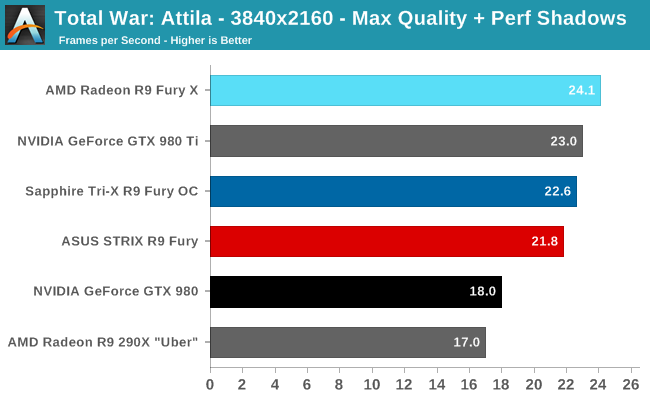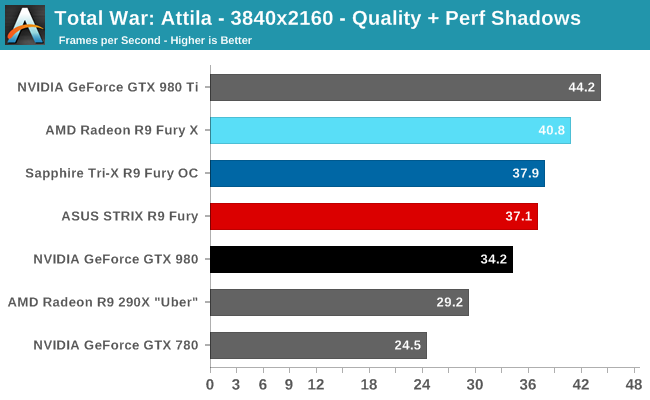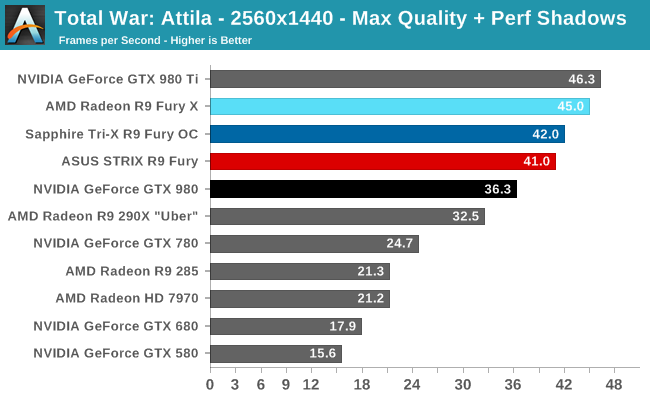The AMD Radeon R9 Fury Review, Feat. Sapphire & ASUS
by Ryan Smith on July 10, 2015 9:00 AM ESTTotal War: Attila
The second strategy game in our benchmark suite, Total War: Attila is the latest game in the Total War franchise. Total War games have traditionally been a mix of CPU and GPU bottlenecks, so it takes a good system on both ends of the equation to do well here. In this case the game comes with a built-in benchmark that plays out over a large area with a fortress in the middle, making it a good GPU stress test.



With Attila the R9 Fury’s lead over the GTX 980 tapers some, but it’s still largely in AMD’s favor. The 13% lead at 1440p continues to be ahead of the 10% price premium, and on an absolute basis it’s enough to keep the R9 Fury over 40fps.
Meanwhile the R9 Fury yet again trails the R9 Fury X by 9-10%, just a bit over the overall average.










288 Comments
View All Comments
FlushedBubblyJock - Wednesday, July 15, 2015 - link
Oh, gee, forgot, it's not amd's fault ... it was "developers and access" which is not amd's fault, either... of course...OMFG
redraider89 - Monday, July 20, 2015 - link
What's your excuse for being such an idiotic, despicable and ugly intel/nvidia fanboy? I don't know, maybe your parents? Somewhere you went wrong.OldSchoolKiller1977 - Sunday, July 26, 2015 - link
I am sorry and NVIDIA fan boys resort to name calling.... what was it that you said and I quote "Hypocrite" :)redraider89 - Monday, July 20, 2015 - link
Your problem is deeper than just that you like intel/nvidia since you apparently hate people who don't like those, and ONLY because they like something different than you do.ant6n - Saturday, July 11, 2015 - link
A third way to look at it is that maybe AMD did it right.Let's say the chip is built from 80% stream processors (by area), the most redundant elements. If some of those functional elements fail during manufacture, they can disable them and sell it as the cheaper card. If something in the other 20% of the chip fails, the whole chip may be garbage. So basically you want a card such that if all the stream processors are functional, the other 20% become the bottleneck, whereas if some of the stream processors fail and they have to sell it as a simple Fury, then the stream processors become the bottleneck.
thomascheng - Saturday, July 11, 2015 - link
That is probably AMD's smart play. Fury was always the intended card. Perfect cards will be the X and perhaps less perfect card will be the Nano.FlushedBubblyJock - Thursday, July 16, 2015 - link
"fury was always the intended card"ROFL
amd fanboy out much ?
I mean it is unbelievable, what you said, and that you said it.
theduckofdeath - Friday, July 24, 2015 - link
Just shut up, Bubby.akamateau - Tuesday, July 14, 2015 - link
Anand has been running DX12 benchmarks last spring. When they compared Radeon 290x to GTX 980 Ti nVidia ordered them to stop. That is why no more DX12 benchmarks have been run.Intel and nVidia are at a huge disadvantage with DX12 and Mantle.
The reason:
AMD IP: Asynchronous Shader Pipelines and Asynchronous Compute Engines.
FlushedBubblyJock - Wednesday, July 15, 2015 - link
We saw mantle benchmarks so your fantasy is a bad amd fanboy delusion.